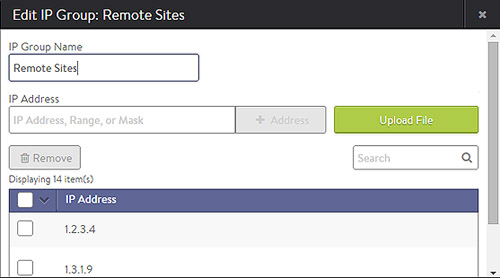IP Group
Description
IP groups are comma-separated lists of IP addresses that may be referenced by profiles, policies, and logs. Each entry may be an IPv4 address, an IP range, an IP/mask, or a country code. IP groups are reusable objects that may be referenced by any number of features attached to any number of virtual services. IP groups are commonly used for service classification, white listing, or black listing.
IP groups may be automatically updated via external API calls. When an IP group is updated, the update is pushed from the Controller to any Service Engines that are hosting virtual services that are leveraging the IP group.
Usage
The following are a few examples of IP groups used within Avi Vantage. Generally anywhere that an IP address may be used, an IP group may be selected instead.
- Policies — A network security or HTTP security policy may be configured to drop any clients coming from a blacklist of IP addresses. Rather than maintain a long list within the policy, Avi Vantage maintains the rule logic of that policy separately from the list of addresses, which are kept in the IP group. A user can be granted a role that allows them to update the list of IP addresses without being able to change the policy itself.
- Logs — Logs classify clients by their IP address and match them against an included geographic country location database. Override this database by using a custom IP group to create specific mappings such as internal IP addresses. For instance, LA_Office may contain 10.1.0.0/16, while NY_Office contains 10.2.0.0/16. Logs will show these clients as originating from these locations. Logs searches may also be performed on the group name such as LA_Office.
- DataScript — Custom decisions may be made based on a client’s inclusion or exclusion in an IP group. Refer to the DataScript function avi.ipgroup.contains for examples and syntax.
- Pool Servers — If multiple pools are needed with different configurations but with the same list of servers, the server IP address can be placed into the IP group. Each subscribing pool will automatically inherit the change in membership if an IP is added or removed from the group.
The table on the Templates > Groups > IP Group page contains the following information for each IP group:
- Name — Name of the IP group.
- IP Address or Ranges — Number of IP address, networks, or address ranges.
- Country Code — Any configured country codes that are listed.
Create an IP Group

To create or edit an IP Group:
- Name — Specify a unique name for the IP group.
- Select by IP Address — Add one or more addresses to the list. You can select any of the following combinations:
- IP Address — Comma separated list: 10.0.0.1, 10.0.0.5
- Range — 10.0.0.10–10.0.0.20
- Mask — 10.1.0.0/16
- Upload File — Click on Upload File button on the right to navigate to and upload a comma-separated-value (CSV) file that contains any combination of IP addresses, range, and/or masks.
- Select by Country Code — Select one or more countries, or type the country name into the search field to filter. Countries may not be combined within an IP group with individual IP addresses. An IP group that contains countries may not be used as a list of servers for pool membership.

